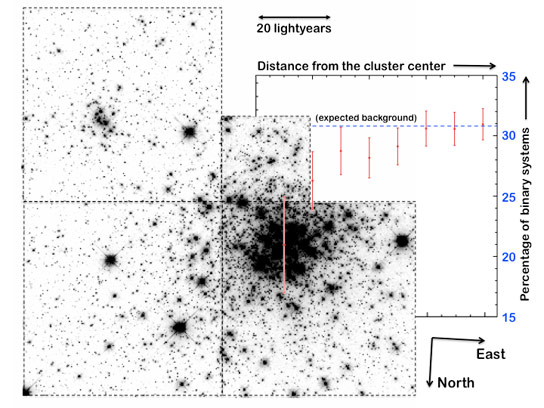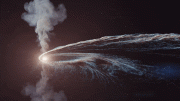
Hubble Space Telescope image of the young star cluster NGC 1818 in the Large Magellanic Cloud. KIAA researchers found to their surprise an increasing fraction of binary systems as they looked at increasingly larger distances from the cluster center, as illustrated graphically in the inset. Credit: Peking University
Findings from a new study suggest that pull of gravity doesn’t fully explain the distribution of stars in crowded clusters and provides new insights into theoretically predicted processes that govern the evolution of star clusters.
Gravity remains the dominant force on large astronomical scales, but when it comes to stars in young star clusters the dynamics in these crowded environments cannot be simply explained by the pull of gravity.
After analyzing Hubble Space Telescope images of star cluster NGC 1818 in the Large Magellanic Cloud, a satellite galaxy of the Milky Way, researchers at the Kavli Institute for Astronomy and Astrophysics (KIAA) at Peking University in Beijing found more binary star systems toward the periphery of the cluster than in the center – the opposite of what they expected. The surprising distribution of binaries is thought to result from complex interactions among stars within young clusters.
The team’s finding will be published in the March 1 print issue of The Astrophysical Journal and is now online.
In the dynamic environment of a star cluster, high-mass stars are thought to gravitate toward the center of a cluster when they give a ‘kick’ to lower-mass stars and lose energy, explained KIAA Prof. Richard de Grijs, who led the study. This leads them to sink to the cluster center, while the lower-mass stars gain energy and might move to orbits at greater distances from the cluster core. Astronomers call this process “mass segregation.”
However, when the Kavli researchers looked closely at binary star systems within NGC 1818, they found a much more complex picture.
Most stars in clusters actually form in pairs, called “binary stars,” which initially are located so close to one another that they interact, resulting in the destruction of some binary systems. Other binaries, meanwhile, swap partners. Astronomers had expected that the same process that leads a cluster’s most massive stars to gravitate toward the center would also apply to binaries. This is because together, the stars that make up binaries have more mass on average than a single star.
When the astronomers discovered that there were more binaries the farther from the core they observed, they were initially baffled by this unexpected result. They concluded that so-called “soft” binary systems, in which the two stars orbit each other at rather large distances, are destroyed due to close encounters with other stars near the cluster’s center. Meanwhile, “hard” binaries, in which the two stars orbit one another at much shorter distances, survive close encounters with other stars much better, all throughout a cluster. This is why more binaries were seen farther out than close in.
Mapping the radial distribution of binary systems in dense star clusters had never been done before for clusters as young as NGC 1818, which is thought to be 15-30 million years old. This is difficult to do in any case, because there are no young clusters nearby in our own Milky Way galaxy. The new result provides new insights into theoretically predicted processes that govern the evolution of star clusters.
“The extremely dynamic interactions among stars in clusters complicates our understanding of gravity,” team member Chengyuan Li said. “One needs to investigate the entire physical environment to fully understand what’s happening in that environment. Things are usually more complex than they appear.”
Reference: “Gravitational Conundrum? Dynamical Mass Segregation Versus Disruption Of Binary Stars In Dense Stellar Systems” by Richard de Grijs, Chengyuan Li, Yong Zheng, Licai Deng, Yi Hu, M. B. N. Kouwenhoven and James E. Wicker, 7 February 2013, The Astrophysical Journal.
DOI: 10.1088/0004-637X/765/1/4









Hi, your statement above ——Gravity remains the dominant force on large astronomical scales,——- has a challenger, cheers 🙂 —-The Limits of Gravitational Theory
The Law of Gravity, which relies exclusively on the masses of celestial bodies and the distances between them, works very well for explaining planetary and satellite motions within our solar system. But when astronomers tried to apply it to galaxies and clusters of galaxies, it turns out that nearly 90% of the mass necessary to account for the observed motion is missing.
The trouble began in 1933 when astronomer Fritz Zwicky calculated the mass-to-light ratio for 8 galaxies in the Coma Cluster of the Coma Berenices (“Berenices’s hair”) constellation. At the time, it was assumed that the amount of visible light coming from stars should be proportional to their masses (a concept called “visual equilibrium”). As Zwicky was to realize, the apparent rapid velocities of the galaxies, around their common center of mass (“barycenter”), suggested that much more mass than could be seen was required to keep the galaxies from flying out of the cluster.
Zwicky concluded that the missing mass must therefore be invisible or “dark”. Other astronomers, such as Sinclair Smith (who performed calculations on the Virgo Cluster in 1936) began to find similar problems. To make matters worse, in the 1970s, radial velocity plots (radius from the center versus stars’ speed of rotation) for stars in the Milky Way galaxy revealed that the speeds flatten out rather than trail down, implying that velocity continues to increase with radius, contrary to what Newton’s Law of Gravity predicts for, and which is observed in, the Solar System.
In short, astronomers using the Gravity Model were forced to add a lot more mass to every galaxy than can be detected at any wavelength. They called this extra matter “dark”; its existence can only be inferred from the failure of predictions. To cover for the insufficiency they gave themselves a blank check, a license to place this imagined stuff wherever needed to make the gravitational model work.
Other mathematical conjectures followed. Assumptions about the redshift of objects in space led to the conclusion that the universe is expanding. Then other speculations led to the notion that the expansion is accelerating. Faced with an untenable situation, astronomers postulated a completely new kind of matter, an invisible “something” that repels rather than attracts. Since Einstein equated mass with energy (E = mc²), this new kind of matter was interpreted as being of a form of mass that acts like pure energy — regardless of the fact that if the matter has no mass it can have no energy according to the equation. Astronomers called it “dark energy”, assigning to it an ability to overcome the very gravity on which the entire theoretical edifice rested.
Dark energy is thought to be something like an electrical field, with one difference. Electric fields are detectable in two ways: when they accelerate electrons, which emit observable photons as synchrotron and Brehmsstrahlung radiation, and by accelerating charged particles as electric currents which are accompanied by magnetic fields, detected through Faraday rotation of polarized light. Dark energy seems to emit nothing and nothing it purportedly does is revealed through a magnetic field. One suggestion is that some property of empty space is responsible. But empty space, by definition, contains no matter and therefore has no energy. The concept of dark energy is philosophically unsound and is a poignant reminder that the gravity-only model never came close to the original expectations for it
Dear Sir, Vacuum space in the cosmos is a dangerous zone and it is not empty one as thought by you. Well, we can infer that the absolute temperature of this vacuum in space is not absolute zero. It is the sink of all the energy outburst in the principal Big Bang explosion which was very very great indeed. Next the Dark Matter and Dark Energy which accounts for 96% of the missing mass in the form of energy equivalent (Your E = mc²) from the initial universe is a real one and no assumption. Dark Matter is doing its dances in splitting the light from the distant galaxies in a kaleidoscopic splitting of the light energy and presents them to us as gravitational lensing effect. The Dark Matter is driving the galaxies against their gravity in fantastic speeds which is observed in ever expanding universe in a paraboloid shape. The Dark Matter may probably form the core of the galaxies and quasars. They are sporadically spread indeed among the real matter worlds though not mixing with them, playing their part in anti-gravitational forces. The Dark Energy consists of hitherto unknown bosons (like yet to be confirmed Higg’s Boson). After all we are familiar with one side of the coin only viz., real matter and anti-matter quarks. The plethora of matter will definitely have other side of the coin consisting like WIMPS which are non-reactive but having huge masses like W± Bosons and Z Bosons and, why not, even Higg’s Bosons.
When the Universe was formed, the forces separated from the colossal energy like E-M forces (with electrical + and – charge), and color forces
(like Red, Blue and Green) of gluons. Gravitational force also would have separated and so much so Dark Energy forces. Thank You.